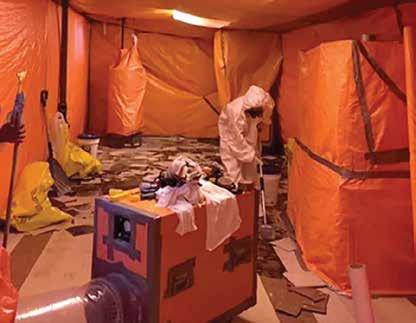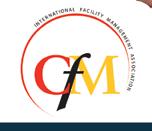




















BOMA Enspire is a national program that offers funding, education and exper tise to help building owners and managers across Canada optimize
T he be nefi t s a r e bu ildin g !
Red uc e op e ra tin g costs Incr ea s e Ass e t Va lu e. Imp rove occup a nt s a tisf a ction
D o your p a r t in t h e t ra nsition to a lo w c a rbon e conomy
S ee y o u a t BO ME X !


T he BO MA E nspir e t ea m w ill b e on ha n d to t a l k a ll t h in g s r e t rofits !

• D rop by our boot h
• Att e n d BO MA E nspir e Ed uc a tion s e ssion s
• Re l a x a n d r e c ha r ge in t h e BO MA E nspir e Re t ro Zon e
• C e l e b ra t e t he 2025 BO MA E nspir e Awa r d w inn e rs w it h u s
W e a r e he r e to suppo r t your p a t h to b e tt e r buil d in g p e r form a nc e
I t ’s g ood bu siness and th e r i ght t hin g to do .
BO MA E nspir e is de li ve r ed by BO M A C a n ada w it h $24 9M fun d in g f rom Na tu ra l
Re sou rc e s C a n ada (NR C a n ) un de r its Dee p Re t rofit Acc e l e ra tor Initi a ti ve (DR AI )
b oma e ns p ir e .c a




Funded by Natural Resources Canada’s Deep





Editor-in-Chief Barbara Carss barbc@mediaedge.ca
Publisher Sean Foley seanf@mediaedge.ca
Art Director Annette Carlucci annettec@mediaedge.ca
Graphic Designer Thuy Huynh-Guinane
Contributing Writers Vila Luker, Elchin Mammadov, Marcia O’Connor, Katie Towey, Xinxin Wang
Production Manager Ines Louis Inesl@mediaedge.ca
National Sales Andrea Almeida andreab@mediaedge.ca Jake Blanchard jakeb@mediaedge.ca Ron Guerra rong@mediaedge.ca
Circulation circulation@mediaedge.ca
Alberta & B.C Sales Dan Gnocato dang@mediaedge.ca
CONTINUOUS IMPROVEMENT models draw heavily on lessons learned from the previous plan-do-check-act cycle to inform the next forward step. Climate volatility is supplying abundant inspiration for that process. As storms, wildfires, drought and heatwaves continue to inflict physical and financial damage in regions throughout Canada and around the world, responsive and innovative risk management procedures and instruments are getting adopted into capital planning, operational and investment decision-making.
Catastrophe bonds are one such timely example. Hurricane Melissa recently triggered the parameters for Jamaica to collect USD $150 million from investors. Coincidentally, we report on Canada’s first catastrophe bond, which TD Insurance issued earlier this year.

The bonds are primarily instruments that insurers and governments use to transfer risk to the capital markets, but they have flow-through implications for property insurance premiums and/or as a portfolio diversification option for investors. The latter comes with a risk of losing part or all of the principal over the bond term, balanced against an attractive risk premium and insulation from other forces in the equities market.
President Kevin Brown kevinb@mediaedge.ca
Group Publisher Sean Foley seanf@mediaedge.ca
Accounting Michele Therien michelet@ mediaedgepublishing.com
TEL: (416) 512-8186
Published and printed four times yearly by MediaEdge Communications Inc. 251 Consumers Road, Suite 1020 Toronto, Ontario M2J 4R3 (416) 512-8186 Fax: (416) 512-8344
e-mail: circulation@mediaedge.ca
Subscription Rates:
Canada: 1 year, $30*; 2 years, $55*
Single Copy Sales: Canada: $12*
Outside Canada:
US 1 year, $85 International $110 *Plus applicable taxes
Reprints:
Requests for permission to reprint any portion of this magazine should be sent to info@mediaedge.ca.
Copyright 2025 Canada Post Canadian Publications Mail
Sales Product Agreement No. 40063056 ISSN 0834-3357
Authors: Canadian Property Management Magazine accepts unsolicited query letters and article suggestions.
Manufacturers:
Those wishing to have their products reviewed should contact the publisher or send information to the attention of the editor.
Sworn Statement of Circulation:
Available from the publisher upon written request. Although Canadian Property Management makes every effort to ensure the accuracy of the information published, we cannot be held liable for any errors or omissions, however caused. Printed in Canada
“Cat bonds have a low correlation to traditional investments,” explains Victor Adesanya, Vice President, Global Insurance and Pension Ratings, with the rating service, Morningstar DBRS. “The outcome depends on the occurrence or non-occurrence of a specific event so certain market events wouldn’t affect a cat bond.”
This issue also looks at recent research tracking how hurricanes affect the performance of publicly traded companies. Those findings show negative consequences, with real estate and utilities demonstrating particular vulnerabilities related to their immobile assets. Researchers highlight the importance of a rigorous risk assessment framework to guide portfolio management.
Many commercial properties are simultaneously absorbing the societal strains of affordability and addiction, which have prompted an influx of troubled shelter-seekers. The Building Owners and Managers Association (BOMA) of Canada offers some guidance on de-escalating tension and other approaches that emphasize compassionate corporate citizenship while maintaining a safe and secure environment for building users.
Meanwhile, recently adopted legislation makes it imperative for Ontario’s commercial and residential landlords to diligently guard against drug trafficking in their buildings, and to document those precautionary measures. We outline the new rules and the possible fines that come with them.
Elsewhere on the safety and security front, new rules are coming into force for Internet and cell phone service providers. The Canadian Radio-television and Telecommunications Commission (CRTC) has defined what qualifies as a system outage and established mandatory response protocol. It has also launched consultations, which could eventually lead to a ruling, to explore compensation for customers when outages occur.
Barbara Carss barbc@mediaedge.ca




8 Empathetic Enforcement: Commercial real estate contends with societal crises manifesting on office and retail properties.
10 Dodgy Traffic: New legislation addresses illegal drug activity and human trafficking in commercial and multifamily properties.
16 Telecom Triage: The Canadian Radio-television and Telecommunications Commission mandates new protocols for system outages.
18 Catastrophe Contingency: Climate perils inspire new investment products.
22 Market Blow: Hurricane exposure swirls out to investment performance.
28 Extinguishing Exposure: Canadian government proposes new controls on firefighting foams.
36 Scam Screen: Rental fraud incidents rise with financial stresses.
6 Tool of Change: AI literacy gaining prominence in commercial real estate’s skill set.
24 Fresh Resource: Health Canada releases indoor air quality guidance for office buildings.
30 Express Learning Curve: BOMI Education Canada launches new micro-credentials.
34 Economic Clout: Commercial real estate generates jobs and spending.














Having the technical expertise and insight to conduct retrofit projects in established buildings without affecting the day-to-day business of occupants is our specialty. It’s what sets us apart.
The truth is, existing buildings are far more complex and challenging than new construction, and require a unique game plan every time. It’s why the process for delivering mechanical and electrical engineering solutions requires more than a cookie cutter approach – it demands that you have a deep insight into the building and how new systems can be integrated into existing systems seamlessly.
All of our projects are reviewed by senior engineers, each with over 30 years of experience in their respective fields, ensuring that our clients always receive engineering services of the highest quality.
T: 416-443-9499 | E: marketing@mcgregor-allsop.com mcgregor-allsop.com










By Barbara Carss

LAZY THINKERS, not evil geniuses, could ultimately be the most menacing force that artificial intelligence (AI) enables. Enthusiasts and more cautious adopters alike underscore the continuing role for informed human override as AI delivers up computations, conclusions and corollaries.
“I do see a use for it in many mundane tasks that we don’t want people to have to do, but, if you depend on AI without understanding the basics of what is being interpreted, do you have the ability to do critical thinking?” Judy Wall, President of East Port Properties, mused during a panel discussion at the Building Owners and Managers Association (BOMA) of Canada’s recent annual national conference. “I worry about using less and less of our brains and then, when it’s needed, it’s like you’ll have to go fire up the coal furnace to see if you still remember how to think.”
As is customary for the BOMEX event’s signature executive roundtable, Wall and two other prominent peers were tasked with weighing in on issues that gripped and galvanized the commercial real estate industry over the past year and are expected to hold sway into the future. AI led that list.
Michael Bansil, Senior Vice President, Business Excellence and Innovation, with GWL Realty Advisors, and Ben Young, President and Chief Executive Officer of Southwest Properties,
sketched out their companies’ experience and AI adoption approach thus far — and, similar to Wall, voiced some reservations along with an acknowledgement that the technology is steadily and rapidly becoming entrenched in the day-today functioning of society.
Early implementation efforts have largely focused on optimizing building systems, augmenting employees’ work procedures, alleviating labour-intensive tasks where appropriate, and collecting, managing and analyzing data. Bansil identifies “AI literacy” as a building block for all those objectives, and the starting point for corporate adoption. In GWLRA’s case, initial exploratory consulting helped it recognize what it could not, or did not need to do, and gave direction to its strategy.
The company sidestepped the costs, logistical complications and threat of obsolescence inherent in developing its own in-house AI tool and, instead, opted for plug-in devices and existing apps for building and energy systems. All employees are actively encouraged to use Microsoft Copilot’s summary, comparison, analytical and content creation tools in their work.
“That’s the one thing that we are really trying to drive,” Bansil reiterated. “Understanding how to use AI is going to be
so important for adoption once an organization gets to the point of full blown implementation. You have to keep pace with it. You can’t start from nothing and all of a sudden expect that you can deploy AI into a solution.”
“I think the biggest risk is not embracing it,” Young concurred. “The adoption of new technology is happening so fast now that you have to get out in front of it.”
For Southwest Properties, a developer/ owner/manager of a Halifax-based multifamily portfolio, emergent AI capabilities have been well matched with the city’s post-COVID population growth and residential building boom. AI now performs much of the traditionally time-consuming task of floorplate configuration, quickly producing a first draft from inputted instructions for the size and number of units, and required common area components like elevators and staircases. However, human designers and decisionmakers then refine it from there.
“You can start to manipulate the data in real time — for example, tell it that you want to shorten the hallways or add more onebedrooms — and really use the tool,” Young explained. “But it is just a tool and should be used as a tool. It gives you something that is close, but you still need to dissect and look at every inch of that layout if you want to maximize it.”


Similarly, he suggests managers and operators could gain new and more fulsome insights as they become more familiar with AI’s data resources.
“I think it allows people to be curious,” Young hypothesized. “You can gather data; you can look at data; there’s so much more information available. Curiosity leads to innovation; it leads to improvements; and it leads to better deliverables.”
On the flipside, some degree of resistance and skepticism is almost preordained within organizations. Bansil noted that the effectiveness of the technology is just one element of fostering uptake. Expert technological support, from either the AI provider or a third party consultant, and a competent in-house implementation team are also part of the formula.
“Our [management and operation] teams don’t necessarily believe the capability itself in some of the AI technologies out there,” he conceded. “But that’s okay because I think that gap will be bridged at some point. If you have tried AI, you know it’s not perfect, but the capability is there. At some point, it’s going to get to where the solutioning for us is going to be pretty rock solid.”
For now, there’s little evidence that AI is yet replacing human workers on a mass scale. Most commercial real estate firms are still in the early stages of adoption where, if anything, extra human resources and effort may be required to navigate the



learning curve. However, the panellists do have a sense of what roles may be vulnerable.
“You have to ask yourself: Do I have a job where I do the exact same thing every day? If you do, that could be a potential for replacement,” Bansil speculated. “If you have a job where you might do something different every day, it is much more difficult to replace roles like that.”
Young warns that human intervention will still be needed — and should remain accessible — behind any chain of AI service provision.
“We really try to focus on that customer-facing experience, and there’s a point where they want to talk to somebody,” he said. “That is where you shut the technology and put the person in play who is going to be the one to figure it out. The companies that stray too far from that will lose the customer service touch.”
There’s also the risk of what Bansil calls “cut-and-paste syndrome” with users too often unquestioningly relying on AI conclusions or even duplicitously passing off AI-engendered content and analysis as their own. Wall stressed the importance of critical thinking and suggested that schools, post-secondary institutions and industryfocused continuing education may all need to pay heightened attention to it.
“As we use it, we need to be curious and inquisitive,” she asserted. “If that happens, I am all for AI.”
Meanwhile, the cut-and-pasters may just be fooling themselves.
“In the end, if you rely totally on AI to be your decisionmaker, you still own that decision,” Bansil observed.






A combination of eroding affordability, rising opioid dependency and diminished downtown foot traffic has pushed more shelter seekers into commercial buildings in many Canadian cities. That, in turn, has compelled property managers and their security personnel to confront the societal crises of homelessness and addiction, while continuing to prioritize tenants’ needs for safe, peaceable space in which to conduct business and engage their clients and customers.
A new whitepaper from the Building Owners and Managers Association (BOMA) of Canada delves into some of the complex issues and conflicting interests that underlie the dilemma, drawing on the insights and experiences of major commercial real estate managers and community-based social services providers. The following is an excerpt –Editor.
TRADITIONALLY, third-party security guards would immediately escort someone under the influence of drugs — or any person who had overstayed their welcome — off the premises without looking into their well-being. In recent years, however, it’s become clear that simply removing people struggling with opioid-use disorder (OUD) from commercial property isn’t solving long-term problems for anyone.
Smart real estate companies are beginning to explore different strategies, adopting a new approach and trying to help vulnerable people in a meaningful way. While the current opioid crisis is both frustrating and heartbreaking to witness, building owners and security professionals are starting to adopt strategies to meet these challenges with compassion.
“When I started in this industry it was all about deterrents and intimidation. You didn’t have to use
language to reason with people or de-escalate them. It has now evolved to the point where your best tool is your brain and your language,” reflects Christopher Morgan, Director of Security and Operations Compliance – Property Management for JLL Canada.
People in the grips of drug and alcohol use have always been present, but the broader public is now more likely to encounter them — or be called upon to administer life-saving naloxone — in an array of previously unexpected places, both downtown and in the suburbs.
“In part because of COVID and so many buildings being vacated and shut down, drugrelated activity has moved into areas where we haven’t seen it before. We’re finding needles and signs of drug use in all areas of the buildings we manage,” observes Paul Huston, Global Chief Security Officer at BGIS.
That’s not just less-frequented stairwells, alcoves and parkades. It’s evident in building lobbies, retail stores, outdoor common areas and other publicly accessible spaces.
Security personnel are typically mediators to this influx, responsible for managing the unpredictable behaviour of those with OUD while also worrying about the safety of tenants when needles or broken glass are left on the property. Although it’s rare for individuals using drugs to physically endanger tenants or customers, the perception of potential harm is a real issue affecting property managers and building owners.
Even if a distressed person experiencing addiction is harmless to passersby, incidents between security and a person under the influence can be loud and alarming. When captured on phone cameras, such scenes can create the public perception that a retail building or workplaceisunsafe,leavingpropertymanagement to deal with the reaction from tenants and customers.
“We’re seeing a gap between perceived safety and security and actual safety and security,” says Philip De Wolf, Senior Manager of Health and Safety and Emergency Management at RioCan Real Estate Investment Trust. “After any incident, we’ve had to leverage our partnerships with our
communication experts to help manage the message with our tenants, especially in our mixed-use centres.”
The risk of negative perception makes it an issue that can’t be ignored. But managing the issue comes with a cost — both in time and money. Investment will be required in safety messaging for tenants and the broader public, staff training and other equipment to respond to people in distress.
For example, the cubicles in gender-neutral public washrooms are typically outfitted with floorto-ceiling doors to ensure occupants’ privacy, but that also makes it impossible to visually detect emergency situations, such as loss of consciousness, from the outside. JLL is now testing a sensor that can detect when someone is lying on the floor, which comes at a cost of $10,000 per stall. As well, prompt response from building personnel continues to be the life-saving element once that sensor triggers an alarm.
Reliance on third-party security providers, which typically have high employee turnover rates, can make it challenging to retain on-site personnel trained in the nuances of de-escalation. Real estate companies have increasingly come to realize that paying higher salaries to staff who have the needed training and experience will bring better returns in the form of satisfied tenants and clients, along with better outcomes for people with OUD.
Security guards have learned to administer naloxone through BGIS’ training initiatives, while RioCan has focused on de-escalation tactics and improving awareness of addiction and mental health.
“When incidents do occur, they’re able to de-escalate the situation and manage until police arrive,” De Wolf says.
“We’ve saved two people’s lives because of that [training], which gives them another chance to get the help and support they need,” Huston recounts.
In Montreal, JLL has forged a partnership with the Société de développement social (SDS) to build formal connections between social workers and real estate management teams. The SDS team, led byJanikFortin,DirectorofProjectsandDevelopment, is on call to respond to incidents or visitors who raise concern on a JLL-managed property.
“We know how to react and talk to people in distress,” Fortin explains. “We’re not in a rush. If I need to spend two hours on an intervention, that’s okay. Then our teams can help the person access the resources they need.”
JLL has correspondingly revised its security protocols to take a more intentionally empathetic approach to loiterers who previously were characterized as nuisances. For example, staff monitor the “regulars” who are routinely seen on the property for signs of change in their physical and mental health, and also interact with them to gauge whether they could be receptive to more formal
Commercial real estate’s symbiotic relationship with downtown ambience is evident in good times and bad — and, currently, times could be better in many major Canadian cities. The Building Owners and Managers Association (BOMA) of Canada flagged deteriorating downtowns as an “issue keeping the industry up at night” in its 2024 Yearbook, summarizing the association’s activities, achievements and ongoing priorities.
BOMA Canada’s President and Chief Executive Officer, Benjamin Shinewald, also tallied downtown decline among the many economic uncertainties the industry faces during his recent address at BOMEX 2025, the annual national gathering of BOMA members, which was held in Halifax this year.
“Our downtowns are crumbling,” he asserted. “At BOMA Canada we’re spending a lot of time talking about how to build coalitions around downtown revitalization, working with other organizations as well. It matters to the vibrancy of our economy, partly because our assets are heavily downtown-based. If they start falling in value, that’s bad for the economy, and it becomes a vicious cycle because the property taxes will only rise to make up for the difference.”
assistance. In more than one case, such individuals have been guided into treatment and affordable housing programs and have gone on to reintegrate into mainstream society.
The Montreal program is tapped as a potential template for rollout across JLL’s portfolio and more broadly. Proponents acknowledge that may require “significant financial support” but also tally the paybacks in improved security, safety and well-being. For now, too, it can be characterized as critical and ethical troubleshooting in the absence of a societal fix for the root causes of addiction.
“The real estate industry has a major role in this,” Morgan contends. “If people are on our
property, we need to be part of the solution. We have a responsibility to participate.”
The initiative also dovetails with the work of BOMA Canada’s stakeholders’ group on downtown revitalization. Representatives from the Ontario Chamber of Commerce, the Canadian Bankers Association and the Business Council of Canada, among others, have joined to tackle a range of associated issues and challenges, including the addiction crisis.
The full text of BOMA Canada’s whitepaper, Commercial Real Estate and the Addiction Crisis, can be found at https://bomacanada.ca/ safety-security-insights.


LANDLORDS AND condominium corporations in Ontario may want to augment their due diligence procedures to ensure they can demonstrate efforts to prevent illegal drug activity in their buildings. New provincial legislation, which received Royal Assent in June 2025, targets landlords who knowingly permit the production or trafficking of controlled substances within premises they control and/or who knowingly possess the proceeds from such activity.
That comes with the possibility of hefty fines and/or jail time, and the potential for corporate officers and directors to be personally penalized. However, as with the Occupiers’ Liability Act, the Act allows the defence that “reasonable measures” were in place to guard against criminal activity.
The government has promised more details on what that might entail in future regulations and guidance documents.
“Depending on the context of the situation, reasonable measures can include actions such as informing the police and/or commencing an eviction process,” states associated background posted on Ontario’s regulatory registry for public consultation earlier this spring. “What is reasonable in a specific scenario will depend on the facts.”
The legislation applies to owners who have leased commercial or residential property or to head tenants who have sublet the space to perpetrators of illegal drug activity. Legal specialists draw a clear distinction between the proposed Act’s direct targeting
of landlords for specified offences versus the Occupiers’ Liability Act’s more general assignment of a duty of care for people coming onto a property. However, there are some parallel best practices for precautions. Regular inspections coupled with written inspection reports provide a good basis for proving landlords have made reasonable efforts to address risk. In relation to the Occupiers’ Liability Act, Joe Hoffer, a partner and counsel with Cohen Highley LLP, recommends an initial inspection and corresponding report when a tenant first occupies a space, and a follow-up three months later. Provided there is no cause for concern, annual inspections should then suffice.
Alternatively, it’s important to investigate if there are signs of suspicious behaviour or

activities, or complaints from other building occupants. Residential landlords are already responsible for ensuring a safe and peaceable environment, as stipulated in Ontario’s Residential Tenancies Act (RTA), so the new Act simply adds another layer of offences and liability.
“If there is evidence the landlord knew or ought to have known of the activity — for example, based on the allegations of neighboring tenants — but chose not to investigate or commence eviction proceedings, then not only would the landlord be liable under the RTA for failing to ensure the complaining tenants’ ‘reasonable enjoyment’, but would also be liable under [this legislation] when it’s enacted,” Hoffer observes. “In a condo setting, the proper step would be for the corporation to apply to the Court for an order against the unit owner and/ or the tenant requiring that the owner/tenant cease the activity and/or giving vacant possession and sale of the unit.”
The Act establishes various compounding penalties for offenders. Individuals convicted of knowingly permitting illegal drug activity would be subject to a fine of $10,000 to $250,000 and/or up to two years of

Ontario municipalities will have an optional set of fines for enforcing fire safety when administrative monetary penalties (AMPs) tied to the Fire Protection and Prevention Act (FPPA) take effect Jan. 1, 2026.. This has already been authorized through 2024 amendments to the Act, but not yet been proclaimed into law.
Earlier this year, the public was invited to submit comments on the Ministry of the Solicitor General’s proposed parameters, including: offences to which AMPs may apply; officials authorized to impose AMPs; the fee schedule; and opportunities to dispute penalties. A consultation paper posted on Ontario’s regulatory registry indicated AMPs are intended as a measure to address violations of Fire Code provisions related to record-keeping or other details that pose a low risk to life-safety and do not require specialized or technical knowledge to assess.
“Once this framework is in place, municipalities would have the option to use AMPs as a progressive enforcement tool that could be imposed upon anyone, including tenants, owners and corporations, who contravenes the FPPA and its regulations. AMPs may be used alone or in conjunction with other enforcement tools under the FPPA,” the preamble to the consultation paper states.
Meanwhile, the FPPA itself states: “An administrative penalty may be imposed alone or in conjunction with any other regulatory measure provided by this or any other Act, and may be imposed in
imprisonment for a first conviction, while a subsequent conviction would merit a fine of $5,000 to $100,000 for each day the offence occurs and/or imprisonment for up to two years. For corporations, fines are set
conjunction with a fine imposed for the same infraction.”
Designated assistants to the Fire Marshall (AFM), who currently issue tickets under the Provincial Offences Act (POA) for offences related to the FPPA, are tapped as logical officials to issue AMPs. These technical experts are typically already embedded within municipal fire departments or are staff within the Office of the Fire Marshall serving areas without a municipal fire department.
The consultation paper suggests AMPs for a first offence would not exceed the fines set out in the POA, which range from $195 to $295, but a subsequent contravention within a three-year period would be subject to higher penalties. Under the yet-to-be-proclaimed enabling legislation, those would top out at $10,000 for an individual and $100,000 for corporations and organizations. However, the government will prescribe precise fine amounts in regulation, which will be consistent province-wide, as AMPs come into force.
Recipients of AMP orders will have a 30-day period to submit a request for a review, and a 30-day period to pay once an order has been finalized. Proceeds from AMPs are to be directed to the administering municipalities or the Ontario government’s consolidated revenue fund in unorganized areas. It’s proposed that outstanding payments from property owners may be collected through either municipal property tax or provincial land tax.
at $25,000 to $1 million for a first conviction, and at $10,000 to $500,000 per day for subsequent convictions.
Additionally, individuals would face a fine of up to $100,000 and/or up to one
year in prison for knowingly possessing the proceeds of illegal drug activity, or for re-entering or attempting to re-enter a property that has been closed due to illegal drug activity. (Sitting tenants of a residential property are excepted in the latter scenario since the RTA stipulates that Ontario’s Landlord and Tenant Board must formally evict them.) Corporations would be subject to fines of up to $250,000 for the same offences.
The definition of knowingly possessing the proceeds goes beyond collecting rent or condo fees from a perpetrator. Hoffer suggests investigators, and ultimately the Courts, would be looking for evidence of some kind of irregular payment such as rents that are well above the market rate or a substantial deposit of key money for the lease.
Regardless, Crown prosecutors would still have to prove that landlords colluded with law-breaking tenants on both the charges of knowingly permitting illegal drug activity and knowingly possessing the proceeds. That’s likely to be a more difficult test than simply demonstrating negligence. Hoffer characterizes a landlord’s or condo board’s inaction on


complaints or other evidence of drug production/trafficking as “some prima facie evidence of failure to exercise due diligence” but not the complete makings of a case.
The Ontario government has also announced that the Accommodation Sector Registration of Guests Act will go into force on Jan. 1, 2026. That legislation, which was passed in 2021, will require hotels and online accommodations platforms to keep a register of each transacted bedroom or suite, containing the name, address and possible other prescribed information about at least one of the occupying guests.
This register is to be made available to the police, under prescribed circumstances set out in the legislation, when there are grounds to believe the occupant is a victim of human trafficking or at imminent risk of being trafficked. The Act also includes requirements for police services to report annually on the circumstances in which they have sought access to these registers.
Hoteliers and operators of online


accommodations platforms could be fined up to $5,000 for failing to maintain the register or for knowingly allowing false information to be recorded. Guests who provide false information would also be liable for fines of up to $5,000.
Meanwhile, the Manitoba government has shortened the timeline for residential evictions if a tenant is engaged in drug, cannabis or human trafficking. Prior to the June 2025 passing of a new amendment to the provincial Residential Tenancies Act, the legislation already authorized evictions within five days in cases where there is an immediate risk to the health and safety of other building occupants. The recent amendment now creates a new category of “significant risk” related to the three designated types of trafficking activities.
This is meant to address situations such as the one Manitoba’s Minister of Justice and Attorney General, Matt Wiebe, cited earlier this spring while introducing the bill for second reading in the legislative assembly. In that case, video evidence provided ample evidence of non-residents


entering and exiting a particular unit where drug trafficking was believed to be occurring, but this could not be construed as an immediate risk to others’ health and safety.
With the new amendment, hearings officers with the Residential Tenancies Branch can order an eviction based on evidence from one or more designated sources, including: police officers; investigators with the provincial Public Safety Investigation Unit (PSIU); security guards or building operations staff; emergency services first responders; municipal bylaw inspectors; public health inspectors; staff with a family and child services agency; or those deemed to have “specialized knowledge, training or experience on indicators of unlawful activity”.
“Our government believes that trafficking in drugs and human beings is always a risk to public safety, which is why we are changing this law,” Wiebe said. “If the landlord proves, on balance of probabilities, that the tenant is engaging in drug or human trafficking, such activity will be deemed a significant risk to safety.”




Proposed changes to Nova Scotia’s Residential Tenancies Act would allow domestic violence sufferers to displace their abusers and retain occupancy rights.
Under current rules, tenants can terminate their leases, free from financial penalty, with just one month’s notice if they have applicable documentation from the provincial Director of Victim of Services. That will trigger a blanket termination for all occupants, regardless of whether they are also parties to the lease.
It’s now proposed that qualified applicants can simultaneously give notice that they wish to enter a new lease, with the same terms, for the same premises. Landlords would then have 10 days to apply to Nova Scotia’s Director of Residential Tenancies for permission to deny the request, and a decision must be rendered within 14 days. The subject
tenant can continue to occupy the unit during that period.
Landlords would not be permitted to “arbitrarily or unreasonably” withhold consent when requested, and would be obligated to keep certifying documents that tenants have supplied confidential. New leases under this clause would have the same expiry date as the legacy lease agreement.
The Nova Scotia government is also looking to reduce the timeline for the required advance notice to quit rental space within a landlord’s private home. Another proposed amendment would set that period at a minimum of seven days, for both landlords and tenants, in cases where the two parties share either or both a common kitchen and bathroom and are not in a domestic relationship. This is framed as a move to “encourage more people to rent out rooms”, which is also consistent with the rules in other Canadian provinces.

until December 31, 2025*










INTERNET AND CELL PHONE service providers in Canada must be ready to comply with new protocols for responding to and reporting major system outages by November this year. The deadline comes in a recently issued directive from the Canadian Radio-television and Telecommunications Commission (CRTC) that builds on interim requirements introduced in 2023.
The rules set out determining factors and timelines for when and how quickly service providers must report system outages to the CRTC, federal departments with oversight for public safety and business operations, provincial/territorial emergency management organizations and local-level 911 call centres. As well, the CRTC has launched two new public consultation processes to gather input on potential improvements to telecom network design/operations and consumer protection mechanisms related to service loss.
“Canadians need reliable Internet, phone and television services. Disruptions to these services can have harmful effects, especially in emergency situations,” observes Vicky Eatrides, the CRTC’s Chair and Chief Executive Officer.
The directive applies to primary telecommunication service, which encompasses wireless or landline phone numbers, Internet connections and data links for end-users. A major outage is now formally defined as one that lasts at least 30 minutes and:
• causes 600,000 minutes of disruption, calculated according to the total number of end-users affected; or
• cuts off telecom access in a community that Statistics Canada categorizes as rural, remote or isolated; or
• affects TTY-IP relay-based services for people with hearing or speech disabilities; or
• affects 988 service for mental health crises and suicide prevention.
In such cases, telecom service providers (TSPs) will be required to notify key public safety contacts, such as 911 call centres in
affected areas and provincial/territorial emergency management organizations that administer wireless public alerts, within 30 minutes. The CRTC and the federal department of Innovation, Science and Economic Development (ISED) must also be notified within 30 minutes if the service outage involves 911 networks, wireless public alert systems or specialized services for people with hearing/ speech disabilities or for mental health response.
Meanwhile, for all outages, the CRTC and ISED must be provided with a comprehensive list of specified details within two hours. These include:
• the geographic area, networks, associated brands or downstream TSPs and estimated number of end-users affected;
• the start-time of the outage and estimated time for service restoration;
• a brief description of the causes of the outage (if known), the steps taken to restore service and/or the factors that are preventing network repair and service restorations; and
• a description of how the outage has been communicated to end-users and other stakeholders, including a link to webpages or other channels used to do so.
In the aftermath of a major outage, TSPs must submit a post-occurrence report to CRTC and ISED within 30 days. This calls for much of the same information previously required in notifications at the time of an outage, but also asks for a summary of planned or implemented measures to prevent similar future outages and to improve service reliability and network resilience, along with a timetable for when such measures will be completed. Additionally, service providers will be expected to explain what lessons they have learned from the outage and its spinoff outcomes.
“Post-outage reports may contain confidential information,” the CRTC ruling acknowledges. “However, the lessons learned by a TSP from a major service outage event can benefit the industry by helping to prevent and address future outages. The Commission therefore
encourages TSPs to share lessons learned that the Commission can make public to inform other TSPs.”
Information gleaned from both service providers’ notifications and post-outage reports will build a database to help CRTC and ISED chart the frequency and causes of major outages and the nature and effectiveness of service providers’ responses.
“This information will help the Commission establish evidence-based policies to improve the reliability of services,” the CRTC ruling maintains.
Similarly, the two public consultations are meant to inform future regulatory policy. Stakeholder groups and the general public can make submissions addressing three general themes related to telecom system reliability and resiliency until Dec. 3, 2025, while those seeking to weigh in on consumer protections are asked to consider a series of questions as part of a public proceeding.
“The Commission holds the preliminary view that consumer protections in the event of service outages or disruptions are necessary,” the consultation document states. “To build on the existing consumer protections in place, Canadians may need better protections, including clearer communications or refunds when they experience a service outage with their home Internet, wireless, telephone or television services.”
Telecom service providers or their representative industry groups are additionally asked to provide information about their current policies related to service outages and disruptions, and how those policies are applied and communicated to customers. This had to be submitted by Oct. 9, 2025 in order for them to be recognized as a party to the proceedings.
Stakeholders and the general public have until Nov. 13, 2025 to submit comments.
The CRTC ruling on required protocol for telecom system outages can be found at https://crtc.gc.ca/ eng/archive/2025/2025-225.htm.


By Barbara Carss
CLIMATE PERILS are pushing insurers to explore new ways to diversify risk, likewise inspiring new investment products. Earlier this year, TD Insurance issued the first Canadian catastrophe bond tied to the risk of earthquakes and severe convective storms, such as hurricanes, hailstorms, derechos and tornadoes, within Canada.
Colloquially known as “cat” bonds, the bonds are primarily instruments to serve insurers’ purposes, but they have implications for policy holders and investors. That includes the potential to mitigate rising premiums and options for diversifying investment portfolios that could align with climate action agendas. The Canadian debut follows what’s characterized as a correction in the global reinsurance market that has generally translated into higher rates, more stringent terms and changes in the weighting of risk.
“As the frequency and severity of natural catastrophes increases, it’s very important that we evolve our approach to stay ahead of those loss trends,” observed James Russell, President and Chief Executive Officer of TD Insurance, during a webinar sponsored by the financial ratings agency, Morningstar DBRS. “The traditional approach to managing this risk is to increase the amount of reinsurance purchased. That also drives up costs and that’s where diversification can help. This is where the cat bond really fits in.”
Cat bonds have emerged over the past decade as a means for issuers — typically insurance companies and governments — to transfer risk to the capital markets. Proceeds from the bond placement are invested in high-yield, highly
liquid securities, which are held in a trust account as collateral and then paid out if/when insurance claims related to a single specified kind of catastrophic event reach a triggering level.
The bonds have a fixed term, maturing in one to five years. Investors receive the interest on the securities in the collateral account and an additional risk premium over that period. However, they could lose part or all of their principal depending on the volume of payouts during the bond term.
The fixed term is the attractive element for bond sponsors, allowing them to lock in protection for a multi-year period and hedge against a fluctuating reinsurance market. For investors, there is an opportunity for robust returns with what can be a low probability of loss, depending on the bond parameters.

In the case of the TD Insurance bond, for example, payout from the collateral account is triggered when a qualifying event exceeds CAD $2.35 billion in claims, but is terminated once claims surpass CAD $2.5 billion.
“I believe the modelled risk was 0.4%,” Russell noted. “So, investors get a risk premium [3.29%], which is greater than the probability of reaching this.”
Victor Adesanya, Vice President, Global Insurance and Pension Ratings, with Morningstar DBRS, cited data from Swiss Re showing that cat bonds delivered a 17.29% average return, globally, to investors last year, down from the record high of 19.69% in 2023. Across a broader portfolio, the bonds could be characterized as nonconformists dancing to their own tune.
“Cat bonds have a low correlation to traditional investments. The outcome depends on the occurrence or non-occurrence of a specific event so certain market events wouldn’t affect a cat bond,” Adesanya advised. “That low correlation gives a good mix to a portfolio.”
At CAD $150 million, TD Insurance’s threeyear bond is a small portion of the roughly USD $7 billion in cat bonds issued in the first four months of 2025. Insurers based in the United States, such as Allstate, USAA, California Earthquake Authority and State Farm, have been among the most active sponsors.
“Most of the cat bonds issued are for U.S. perils,” Adesanya affirmed. “It’s understandable because the U.S. has a big exposure to catastrophe risk. They’ve got hurricane season, earthquakes in California and wildfires.”
Russell suggests the Canadian bond now offers a new element of diversification within the alternative asset class since it is tied to different perils. He reported “overwhelming positive response from investors and reinsurance partners” to the first bond placement. Notably, the risk premium could be set at the low end of the initial price guidance on the risk spread — 3.25 to 3.75% — based on investor willingness.
The European Bank for Reconstruction and Development (EBRD) provides the backing for the collateral trust account, representing the financial institution’s first Canadiandenominated debt security, or maple bond. This ticked some key boxes, including the stature to attract global investors’ interest and

“The outcome depends on the occurrence or nonoccurrence of a specific event so certain market events wouldn’t affect a cat bond.”
meet the criteria for high-quality collateral, while also giving TD Insurance access to new reinsurance capital with no exposure to currency exchange risk. In turn, EBRD gained entrance to a new market.
“While the likelihood of reaching this level of catastrophe is very low based on the expectancy of a catastrophic event of this magnitude of event occurring, this investment gives us
options to diversify our protection sources,”
Russell said. “I’d say with the increasing frequency and severity of climate-related events, we’ll continue to explore options toward more resilient ways to manage our financial impacts.”
“On the Canadian side, we may see more companies follow what TD has done in terms of issuing a cat bond,” Adesanya added. “I
think the demand for cat bonds in the future will grow.”
Efforts to manage and mitigate physical climate risk are also necessary to fill out this picture. Losses related to natural catastrophes climbed to a record high, surpassing CAD $8 billion in Canada last year, with about half of that total attributed to hailstorms and wildfires in Alberta.
Russell underscored the importance of embedding climate risk management into infrastructure strategies, development planning and building codes.
“If we think about more resilient reconstruction of properties and mitigation in catastrophic-prone areas like flood zones and other things, there are ways to actually reduce costs and the impact of catastrophes on claims,” he said. “It’s really important that good behaviour by clients is rewarded to prevent losses.”

Centralized resources and expertise are now available for local-level planners and emergency responders contemplating the what-ifs and what-nows of natural and human-triggered catastrophes. The newly launched Canadian Centre for Recovery and Resilience — a joint initiative of the Canadian government and the Institute for Catastrophic Loss Reduction (ICLR) — has a mandate to support disaster preparedness, response and rebuilding in a way that will mitigate future risks.
The new resource centre is one of the recommendations coming out of a review of the federal program for financial assistance for disasters earlier this decade. That consultation process underscored the importance of rapid and coordinated recovery efforts to ensure resources are allocated as effectively as possible when a disaster occurs, and also the need to assess where physical and organizational vulnerabilities occur and how to guard against them in the future.
“As climate disasters grow more frequent and severe, communities in Canada are on the front lines of adapting to these new realities,” observes Julie Dubrusin, Canada’s Minister of Environment and Climate Change.
The resource centre is particularly intended to assist smaller local governments that may have fewer staff and local professional services to call upon. However, it promises a menu of “practical” supports for municipalities and organizations of all sizes.
That includes direct support to develop recovery plans in advance of the need to respond, access to a network of planning, logistical and risk assessment professionals, and guidance through training exercises, seminars and step-by-step advisories and checklists for navigating required procedures.
“The Canadian Centre for Recovery and Resilience reflects the Institute for Catastrophic Loss Reduction’s commitment to helping communities not only recover after disasters, but also reduce future risks,” affirms ICLR Executive Director, Paul Kovacs.
The new resource centre is located alongside ICLR’s demonstration centre for disaster resiliency in Toronto.
Trusted for over 65 years, we are your proven performer within the Condominium Property Managers and Commercial Real Estate Market. We’re proud to be your premium choice, full-service exterior contractor for large municipal, industrial/commercial, and private projects.
EXPERIENCE. LOYALTY. QUALITY. DEPENDABILITY.
Pacific Paving Ltd. 5845 Luke Road, Unit 204 Mississauga, ON L4W 2K5 T (905) 670-7730 F (905) 670-7631 info@pacificpaving.ca pacificpaving.ca
ASPHALT PAVING | CONCRETE WORKS | WATERMAIN REPAIRS
CIVIL WORKS | BUILDING RESTORATION SERVICES | 24 HOUR EMERGENCY SERVICES






ASSAILED roughly
half the real estate issuers in MSCI’s all country world index (ACWI) during the three years from 2022 to 2024, capturing about 10% of their collective assets in some degree of the maelstrom. Newly released analysis from the investment research firm ranks real estate and utilities as the most risk-exposed among 11 publicly traded sectors, while its real-time linking of hurricane events to stock/unit performance shows a general hit for all affected issuers in the index.
MSCI analysts uncovered a pattern of “statistically significant underperformance” relative to the index benchmark for issuers with storm-struck assets. This typically took form as a steadily worsening drop over the course of 30 business days following an event.
The steepest slope of decline was seen during the first two weeks, but returns continued to diminish from there. Among the 20% of issuers with the greatest share of compromised
assets (fifth quintile), analysts found average returns fell more than 1,400 basis points (bps) below the index benchmark by day 30.
“The magnitude of market underperformance increased with the concentration of asset or revenue exposure to hurricaneaffected areas,” observe the report’s authors, Xinxin Wang, Katie Towey and Elchin Mammadov. “The real estate and utilities sectors are the most sensitive to hurricanes and face elevated downside risk due to the concentration of their fixed physical assets and outputs.”
The data is drawn from MSCI’s geospatial dataset, which pinpoints the location of more than 2 million corporate assets, crossreferenced with the International Best Track Archive for Climate Stewardship (IBTrACS) to identify all tropical cyclones reaching at least Category 1 calibre in 2022, 2023 or 2024. Assets falling within a 200-kilometre radius of the centre of those storms were deemed
to be in the range of impact, and the issuers of those assets were targeted for the study.
Accounting for potential variables, analysts then assessed each issuer’s cumulative variation from the ACWI benchmark average during the five days preceding and 30 days following a hurricane event. Affected issuers were subdivided into five quintiles based on their degree of exposure through either affected assets or output.
The analysts also evaluated: the volatility of returns over the course of the 35-day period; sectoral and regional variations in impact patterns; and, the tail risk, or propensity to vastly underperform or overperform past averages.
Fallout for investors is contingent on the mix of sectors and issuers in their portfolios. Immobile physical assets present challenges for both real estate and utilities, but the vulnerability profile differs in the two sectors.
Real estate reflects a larger number of properties dispersed across broader ownership,
while a smaller number of facilities, with associated infrastructure, underpin a relatively greater share of productive output in the utilities sector. This represents two types of systemic risk potential — if/when hurricane events either affect a vast number of issuers or more selectively undermine a smaller number of large-cap issuers.
MSCI analysts also note that many information technology (IT) and industrial issuers that experienced hurricane impacts during the three-year study period have large weights within the index that “may contribute to outsized hurricane exposure in portfolios”.
Business operators and investors are advised to consider these risks as they make decisions. A proposed framework for doing so draws on six components that are common features of various recognized standards, including the International Sustainability Standards Board (ISSB), CDP (formerly the Carbon Disclosure Project) and Network for
its structure, design and reliance on off-site supplies and services, which will inform an associated estimate of the financial consequences of calamitous events that could damage the asset and/or disrupt business operations and revenues.
Finally, companies and investors should evaluate their readiness to withstand and respond to climate-related risks, and consider implementing adaptation measures that could
real estate firms report minimal direct costs from property damage or rental income losses, they often face broader financial impacts. These include higher insurance deductibles and premiums, as well as increased costs for materials and labour in hurricane-affected regions,” the report states. “Although our analysis focused on stock performance during hurricane events, the market response may not be immediate. For example, shares in rail-





NEW GUIDANCE from Health Canada presents a compilation of best practices for assessing and maintaining indoor air quality (IAQ) in office buildings. That includes considerations for contaminant mitigation, ventilation, operational stewardship, resolving IAQ issues and engaging professional services. It also comes with sample checklists and a companion document with more details about specific contaminants and procedures for detecting them.
“The quality of the air in an office building is the result of the complex interactions between the ventilation system (if present), the building (i.e., age, condition, component mate-
rials, structure and envelope), the climate, the quality of the outdoor air, the furnishings and products present, the work processes and the occupants and their activities,” states the introduction to the guidance, which Health Canada’s Safe Environments Directorate released in mid-September. “Good operational practices can prevent many indoor air quality issues. However, when issues do arise, they can be addressed by implementing corrective actions after identifying the potential cause(s).”
The guidance begins with 10 broad recommendations then drills more deeply into how each might be achieved. Collectively, suggested best practices encompass a mix of:
technical/mechanical measures related to ventilation, filtration/air cleaning and humidity control; rigorous scrutiny to detect and quickly address potential sources of mould; and policies to help prevent undue contaminants associated with housekeeping practices, procurement of building products and furnishings, or renovation and fit-out projects. Various negative impacts on IAQ are tallied, including: insufficient air exchange; moisture penetration; emissions from problematic building materials; permeating soilbased hazards such as radon or environmental contaminants; compromised outdoor air supply; and the activity and density of building
occupants. Generally, building and facilities managers are striving to control such factors, while also maintaining the temperature in the range of 20 to 23.5º Celsius in the winter or 23 to 26º C in the summer and keeping relative humidity below 50%.
The guidance references some ASHRAE standards as a baseline for expected performance, including: Standard 55, Thermal Environmental Conditions for Human Occupancy; Standard 62.1, Ventilation and Acceptable Indoor Air Quality; and Standard 241, Control of Infectious Aerosols. It also highlights ASHRAE’s framework for responding to wildfire smoke and potential heightened levels of particulate matter, released last year as Guideline 44-2024.
A MERV 13 air filter is recommended as the minimum for buildings with return air systems. However, the guidance acknowledges this may not be practically feasible for all ventilation systems, and that gains in the ability to capture particulate and pathogens must be balanced against the increased pressure required to move air through the filter.
Alternatively, or additionally, portable air cleaners are identified as an option to either augment existing building ventilation or in scenarios where there is no mechanical ventilation. Prospective purchasers are advised to choose certified devices that employ a HEPA filter and to pay attention to the product specifications indicating the room size for which it is best suited and the clean air delivery rate (CADR), which indicates its proficiency for removing particulate such as dust, pollen, viruses and tobacco smoke. That comes with a reminder that portable air cleaners are ineffectual against gases, like carbon dioxide (CO2) or carbon monoxide (CO).
The guidance also addresses other ventilationrelated topics such as CO2 monitoring, HVAC zone controls, devices that emit UV radiation for infection control and preventative system maintenance. As well, it recommends a risk assessment to examine how the HVAC system might make the building vulnerable to cybersecurity incidents or to accidental or deliberate dissemination of chemical/biological/environmental toxins.
Another section of the guidance focuses on tasks and functions related to building maintenance, space design, procurement and housekeeping. These are characterized as “stewardship” when there is a conscious effort to consider how they can influence indoor air quality.
“Stewardship includes the day-to-day proactive upkeep and maintenance of the building and building envelope. By promptly identifying and
addressing issues, operators or employers will be able to eliminate or reduce the causes of poor air quality, ideally before the issue becomes serious,” the guidance states. “Building operators should develop and maintain good communication with occupants, and educate employers, custodians, maintenance staff and occupants about the importance of air quality and good practices to follow.”
Building staff should be trained and encouraged to become moisture police. The
guidance recommends regular inspection of the building envelope and plumbing piping to check for deterioration or deficiencies that could allow water or air penetration.
Staff should be able to spot, and have a process to report, evidence such as: condensate around windows, water pipes and exterior walls; efflorescence on brick or concrete; or damage and discoloured walls, floors or ceiling tiles. As well, buildings should be routinely inspected after heavy rainstorms, when accumu-

The Neutral Group is a fully insured, full-service interior renovation general contractor. We specialize in multi-residential suite upgrades and common area renovations. Our innovative suite turnover process, dedicated project management staff and facilities produce outstanding savings with time and money.
PROUDLY SERVING THE GTA FOR 10+ YEARS!

lated snow melts rapidly or during extreme heat events.
Moisture and potential excess humidity are also flagged as housekeeping concerns. In particular, it’s important for carpet cleaning technicians to maximize water extraction from the carpet material. The task should be scheduled for times when building occupancy is low and, ideally, avoided during highly humid periods in summer months.
Sloppy plant watering can likewise turn carpets into mould repositories. Plants should always be placed on a stand or in a container that holds runoff rather than directly on the carpet surface.
The guidance includes several other recommendations related to housekeeping practices and special requirements for construction projects within buildings. Procurement policies figure in both cases, with an emphasis on
controlling the introduction of building materials, furnishings and products that emit gases that could have negative environmental and/or health consequences.
Occupant activity may present a more daunting challenge for property and facilities managers. The 10 overarching best practices set out in the introduction to the guidance include recommendations to:
• maintain protocols to reduce viral and bacterial transmission among building occupants;
• ensure occupants follow workplace procedures related to the use of scents and cleaning products; and
• assess any potential mismatches of intended space and occupant activities, in the context of renovation, fit-out and expansion projects.
These imply something of an enforcer role for building management or employers, with an associated potential for landlord-tenant or manager-worker tensions.
Although it does not specifically address such scenarios, the guidance does extensively outline recommended processes for assessing and resolving IAQ issues. It also acknowledges some of the human emotions that may come into play, and highlights the importance of training, science-based evidence and educational outreach.
“Training should be relevant to the audience and can include how to identify a potential indoor air quality issue and how to report concerns,” the guidance advises. “Occupants should also be made aware of issues unrelated to indoor air, such as ergonomic and psychosocial risk factors (e.g., relationships with co-workers, control over workload), as they can affect perceptions of indoor air quality.”
The full text of Health Canada’s Guidance on Improving Indoor Air Quality in Office Buildings can be found at www.canada.ca/en/ health-canada/services/publications/healthy-living/ guidance-improving-indoor-air-quality-officebuildings.html.



















• Parking Lot Paving
• Asphalt Repair
• Asphalt Maintenance
• Concrete Work
• Roadway Paving
• Driveway Paving
• Curb & Sidewalks
• Catch Basin Repair
• Gravel Installation
• And More...









A PROPOSED phase-out of firefighting foams that contain per- and polyfluoroalkyl substances (PFAS) aligns with the Canadian government’s stated intention to add this class of chemicals to the toxic substance list under the Canadian Environmental Protection Act (CEPA). The public has been invited to provide input on the aqueous film-forming foams (AFFF) that have commonly been used to extinguish burning hazardous liquid fuels, and the feasibility of adopting alternatives that are deemed less detrimental to human health and the natural environment.
PFAS are tapped to be classified as toxic substances due to their adverse properties and potential to be dispersed into the environment in quantities and/or concentrations that could pose immediate or long-term harm to ecosystems and biological diversity or endanger human life. Well documented evidence shows that PFAS exposure can compromise individual organs such as the liver, kidneys and thyroid and/or the body’s immune, nervous and reproductive systems.
The move additionally reflects Canada’s standing as one of the 152 national signatories to the Stockholm Convention on Persistent Organic Pollutants — a global treaty to safeguard against invasive, long-lasting chemicals that can accumulate with damaging consequences in the fatty tissue of humans and wildlife.
Firefighting foams have been central to on-site fire safety preparedness and response in the aviation, petroleum and chemical industries, on board ships and at various other industrial facilities where hazardous products are used or stored. Municipal fire departments are also likely to deploy them, when necessary, when called to incidents at airports or industrial facilities.
AFFFs have been the conventional choice to meet performance specifications set out in
numerous standards, codes and regulatory stipulations, such as the National Fire Code of the Canada (NFCC), Canadian Aviation Regulations (CAR), U.S. National Fire Protection Association (NFPA) standards, the U.S. Department of Defense Military Standard and International Maritime Organization (IMO) rules. However, the consultation document from Environment and Climate Change Canada highlights the emergence of fluorine-free foams (F3) that are seen to be gaining credibility as effective alternatives.
In Canada, Transport Canada introduced new flexibility in 2019 to allow airports and heliports to adopt F3s that can meet safety specifications, and the Billy Bishop Toronto City Airport became the first North American airport facility to do so in 2021. CAN/ULC standard 563, developed in 2022, establishes parameters for F3 liquid concentrates that can be used for aircraft firefighting at airports and aerodromes, but no products have yet been certified under the standard.
Canada’s Department of National Defence (DND) is working toward transitioning to PFAS-free alternatives that are approved for military applications, and the NFCC references the new foams in its informational annex. On the flipside, the consultation document notes that general lack of awareness, concerns about cost and technical challenges and the long shelf life of incumbent PFAS-containing products are barriers to the uptake of F3 formulations.
“Nothing has been identified to suggest that F3 cannot be made to work for all required scenarios that have been conventionally managed by AFFF, but there is still work to be done to optimize their performance,” it states.
Under Canada’s regulatory procedures, PFAS must first be listed as toxic substances under CEPA, after which there is a 42-month
window to have a risk management approach in place. The consultation on firefighting foams is anticipatory work in advance of that yet-to-be-determined deadline.
The federal government announced its intention to designate PFAS in March this year and also outlined associated proposed risk management steps at that time. That’s to begin with the phase-out of firefighting foams and then move on, in two subsequent steps, to consumer applications and formulations for which there are not yet feasible PFAS-free alternatives.
If that process unfolds as envisioned, regulations pertaining to firefighting foams would come into force six months after they are finalized and published in the Canada Gazette. As proposed, manufacture of, and training exercises employing AFFF would be prohibited at that time. Transition periods of varying lengths would be set before the final stoppage of firefighting uses.
These generally align with the schedule that has been established in the European Union. Proposed transition periods range from 18 months for portable fire extinguishers and municipal fire service applications to three years for civil aviation facilities to six years for civilian ships, military uses, offshore oil and gas installations and industrial facilities accommodating designated high hazards.
There would also be new labelling, disclosure and record-keeping requirements. That includes labels to warn of possible crosscontamination in scenarios where firefighting equipment that formerly contained or dispersed AFFF has been retrofitted for PFAS-free formulations.
More information about the proposed phase-out of firefighting foams containing PFAS can be found at www.canada.ca/en/environment-climate-change/ corporate/transparency/consultations/pfasfirefighting-foams-afff-phase1-prohibition.html








By Barbara Carss
A SELECTION of online, short courses are now available to guide career rookies and/or veterans in non-financial disciplines through commercial real estate’s key accounting and budgeting concepts. Attendees at the Building Owners and Managers Association (BOMA) of Canada’s 2025 annual conference were offered complimentary access to one of five short courses that underpin a newly launched micro-credential, which can also be recognized as a component of a full Real Property Administrator (RPA) or Facilities Management Administrator (FMA) designation.
“We’ve introduced the micro-credential to meet skill gap needs in the market. In particular, it’s targeting property managers and facilities managers coming into the industry, to help them get up to speed in the areas where they need to be able to hit the


ground running when they start work for a commercial real estate firm,” explains Andrea Sine, Senior Vice President with BOMA International, who was on hand for BOMA Canada’s BOMEX event in Halifax. “We have heard from a lot of our members that one of the major skill gaps for new hires is financial acumen and financial literacy. So that’s where we started as the baseline for our short courses.”
BOMA’s educational arm, known as BOMI, has thus far introduced two new micro-credentials — Revenue Administration and Mastering the Budget — with a third slated to arrive before year-end 2025. Each micro-credential encompasses five selfdirected, online courses, estimated to each represent about two hours of learning time. Registrants who successfully complete all five short courses earn a digital badge to verify they have achieved the required level of knowledge, and can apply the microcredential toward an RPA or FMA designation.
BOMEX attendees who opted to take Budgeting and Accounting 101 got the added bonus of expert, in-person guidance to walk them through the online overview of cash, accrual and modified accrual accounting methods and concepts such as assets, liabilities and owners’ equity. Kim Saunders, Chair of BOMI Education Canada, and board member, Alex Hanson, led the morning seminar, and later weighed in on the short course content and the flexibility of the just-in-time approach.
“There has been growing attention on the
soft skills of being a property manager — emotional intelligence and inclusive leadership and those kinds of things — but that doesn’t mean the hard skills don’t still matter,” muses Hanson, who is Managing Director of Property Management for Colliers Canada in Saskatchewan. “If you didn’t get a Commerce degree or don’t have a lot of experience, there are not a lot of educational options specific to property management out there for people who need to know how to do the job. This provides a new opening to support development of those hard skills.”
New survey findings suggest women tend to see the skilled trades as a more plausible career path for others than for themselves. Just 9% of women who responded to the Leger survey earlier this summer currently practice a skilled trade, while more than two-thirds report they have neither seriously nor vaguely considered such pursuits.
However, more than three-quarters of female respondents say they would encourage their children and/or mentees to take up a skilled trade — a slightly higher affirmation rate than among male survey respondents.
The results deliver an updated snapshot of the opinions that Leger first collected on behalf of the survey sponsor, Classic Fire + Life Safety, in 2024. This year’s findings are drawn from 1,508 online surveys submitted between Aug. 8 and Aug. 11, 2025.
In total, 15% of this year’s participants work in the skilled trades, up slightly from 13% in the previous year. Demographically, this represents 22% of male respondents, 24% of survey respondents under the age of 35, and 24% who identify as Black, Indigenous or People of Colour (BIPOC).
Results show a year-over-year uptick in the percentage of respondents who have considered a career in the skilled trades — rising from 40 to 43%. Parsing by gender, 56% of male respondents say they have strongly (24%) or somewhat (32%) considered the skilled trades versus 31% of female respondents.
Respondents who practice or have considered pursuing a skilled trade rank the primary attractants as: the hands-on nature of the work (50%); earning potential (48%); job security (38%); and opportunity to start their own business (26%).
This year, a slightly higher percentage — 11% versus 9% in 2024 — has a family history in the skilled trades. Slightly fewer — 8% versus 10% in 2024 — point to peer or mentor influence for their career choice.
Preference for white collar employment (indicated by 25% of respondents) continues to be the top reason for eschewing the trades, while 18% also cite ignorance of career opportunities or perceptions that skilled trades are too physically demanding.
Fewer than 10% consider perceptions about earning prospects, job status or societal expectations to factor into their choices. Attitudes of parents and teachers also have bearing, but with less negative sway in 2025 (13%) than in 2024 (16%).
A sizable majority (62%) of survey respondents perceive that skilled trades are well compensated, but only one-third say they offer a good work-life balance. Fewer still (31%) agree that a career in the skilled trades is respected in society, but 71% say their own opinions of such employment has improved over time.
A larger proportion of men (44%) than women (37%) say they would choose a career in the trades if they could go back in time, but 79% of women (versus 73% of men) believe the skilled trades present more career options now than in the past
A sizable quotient of respondents (14%) have no discernable reason for rejecting the idea of a job in the trades, whereas just 3% of those who are tradespeople or are considering such careers do not know why.
Drilling down to the survey sponsor’s agenda, awareness of life safety career options is less common. In total, 30% of respondents are familiar with fire alarm technicians — 37% of men and 24% of women. Just 22% of total respondents know about the role of sprinkler fitters — 31% of men and 14% of women. Nevertheless, both trades elicit favourable opinions as a possible career path.
The survey is part of Classic Fire + Life Safety’s outreach and recruitment activities.
“Staying on top of perceptions and trends in the skilled trades helps us to better promote the industry, highlight the benefits of a career in fire safety and attract new talent to join our teams across Canada,” says Mike Farren, the company’s Chief Executive Officer.

Along with the introductory 101 lessons, the Revenue Administration microcredential includes short courses focusing on: identifying income sources; recording revenue; measuring property performance; and creating common area maintenance (CAM) reconciliations. The Mastering the Budget micro-credential delves into: developing an income budget; controlling costs; capital budgeting; expense budgeting; and preparing the cash basis income statement.
Each short course has embedded quizzes to ascertain registrants’ grasp of the material, and online students must successfully complete all five pertinent courses to obtain the micro-credential. However, the selfdirected format also accommodates learners with a more scoped agenda — perhaps to refresh their knowledge of some concepts or to explore subject matter that may not be within their daily job functions.
“This is the future of educational convenience. People have very busy lives, but this is a way to break it into manageable pieces,” Sine maintains. “There is an ability to stack all the courses into a designation, but, for people who don’t need or want that, they can just focus on a specific needed skill.”
Saunders, a BOMA Fellow and Property Manager with East Port Properties, contrasts that with her own early career experience. She recalls making her way through the eight required courses for the RPA designation on a more rigid schedule that involved attending physical classes, which were offered on a set timetable, then writing exams.
“Our generation did all that after work. Today’s generation wants instant education and this is a step toward that,” Saunders notes. “You can take the courses in whatever order makes the most sense for you or for the area of the industry you’re working in. Or, for property assistants who want to become property managers, they can start doing these courses and then, when those job opportunities come up, they can be better prepared.”
The micro-credentials are expected to begin figuring in industry mentors’ career advancement advice. Or, ready options for learning curve assistance may give employers more flexibility to consider otherwise strong job candidates who lack some of the skills for required tasks.
“If they’re missing a specific skill, they can take a short course in about two hours and be able to apply those skills immediately on the job,” Sine says. “It helps the learner — the employee — be able to upskill quickly, but it also helps the employer ensure that employees

have the skills they need to be able to do their job quickly and accurately.”
Like all RPA and FMA courses, microcredentials are grounded in a competencybased model, tied to extensive consultation with the industry about required skills and areas of knowledge. Fees are currently set at CAD $69 per individual short course or CAD $329 for a set of five relating to a specific micro-credential.
More information about the new micro-credentials can be found at www.bomicanada.ca/ microcredentials.

The Commercial Real Estate landscape is changing. Property managers and stakeholders look to BOMA Toronto for educational support and resources to help navigate critical issues, deliver operational excellence, and inspire success. Build your skills. Build you network. Build your career. JOIN TODAY! For membership and sponsorship inquiries contact:
Nadeyah Kailan Manager, Stakeholder Engagement
416.596.8065 ext. 227
PROPERTY MANAGEMENT and commercial brokerage services generated more than $160 billion worth of economic activity and underpinned more than 406,000 full-time jobs across the Canadian economy last year. That represents a significant chunk of commercial real estate’s broad economic impact through direct, indirect and induced spending and employment tied to both new construction and existing asset operations.
A newly released report sponsored by the real estate and development industry association, NAIOP, pegs the macro numbers at:
• CAD $342.3 billion in total economic activity, based on the volume of goods consumed across all surveyed CRE sectors;
• a CAD $172.5 billion contribution to national gross domestic product (GDP), measuring the added value that commercial real estate injected into economy; and
• more than 1 million full-time jobs, accounting for workers directly employed in construction and existing asset operations, service providers to those sectors and other jobs that incomes earned through commercial real estate support.
The report, which was prepared by the CRE advisory firm, Altus Group, under the direction of its chief economist, Peter Norman, refreshes findings from a previous 2021 edition and concludes that high interest rates
underpin a slight contraction in economic activity and jobs from three years earlier. A seeming 23% increase in overall economic activity is attributed largely to inflation-triggered higher construction costs, while real economic activity actually dipped about 2%.
A 36% decline in new office construction and a 24% decrease in brokerage activities, relative to 2021 are identified as the leading contributors to that result. Although 2024 saw interest rates easing from 2022 and 2023 levels, the report also acknowledges the challenges 2025 has brought.
“The Canadian economy in 2024 experienced modest growth amid lingering inflation pressures and high interest rates,” it states. “Canada’s next major macroeconomic challenge will involve disruptions to the economy, and potentially the CRE sector, from the evolving trade dispute with the U.S. and, more broadly, fallout from potential disruptions to trade globally.”
Total value of commercial real estate transactions in 2024 was 19% lower than in 2021 — falling from $44.5 billion to $36.2 billion (excluding land sales), and flowing through to a corresponding drop in brokerage fees. However, record-high transaction volume in 2021 also contributes to the magnitude of the gap. Canada-wide, commercial brokerages collected more than $8.1 billion in fees last year,
which surpasses the three pre-pandemic years from 2017 to 2019.
In 2024, property management and operations generated more than $144 billion in economic activity and contributed nearly $86 billion to GDP. In contrast with construction and brokerage services, that’s an upward trend since 2021. That’s related to the post-pandemic rebound and more workers returning to the office.
Commercial brokerage services generated an estimated 63,440 direct, indirect or induced full-time jobs last year, with 27,180 of those workers directly employed in the sector. Commercial property management is a larger benefactor, generating more than 343,000 direct, indirect or induced full-time jobs, with nearly 68,000 workers directly involved in property management or in-house operations.
Last year saw approximately $22.5 billion in employee earnings arise from existing asset operations (both property management and brokerage services), including $5.27 billion paid to workers directly employed in those sectors.
The full text of the NAIOP/Altus report, Economic Impacts of Commercial Real Estate in Canada, 2025 edition, can be found at www.naiop. org/research-and-publications/research-reports/reports/ economic-impacts-of-commercial-real-estate-incanada-2025-edition
Canada’s universe of professionally managed real estate fell in value and nudged down as a proportion of global market share during 2024, but it retains its ranking as the ninth largest market that the index producer, MSCI, monitors. MSCI’s annual overview of the global real estate investment market confirms Canada had plenty of company in a year when the value of surveyed holdings contracted by 4.1% — dropping to USD $12.5 trillion from USD $13 trillion in 2023.
The value of Canada’s market is pegged at USD $375 billion (just shy of CAD $540 billion based on the exchange rate as of Dec. 31, 2024) or about USD $44 billion (CAD $63.3 billion) lower than the previous year. That equates to 3% of global market weight, down from 3.2% in 2023, but back on par with 2022.
Canada is again sandwiched between eighth-ranked Hong Kong and tenth-ranked Switzerland, and both those markets saw value drop by USD $23 billion and USD $19 billion respectively. The United States and 27 other of the 38 monitored markets took the same trajectory.
The U.S. continues to dominate in the global mix, registering a gain of 113 basis points (bps) in overall market weight. However, investment real estate value, estimated at nearly USD $4.9 trillion, was down USD $60 billion from 2023.
The full text of the MSCI 2024 Real Estate Market Size report can be found at www.msci.com/research-and-insights/paper/ msci-real-estate-market-size


Stand out as an industry leader with the Certified Facility Manager® (CFM®) credential, the gold standard of FM.

Showcase your mastery of the globally recognized FM body of knowledge




Gain credibility in your professional network
Empower your career
Did you know that no coursework is required to take the CFM? Because you're tested on your ability to apply FM knowledge, your eligibility is based on your experience and education.
Everything you need to prep for the exam is available through IFMA’s learning portal, fm.training:

Take a practice exam and experience the methodology

Brush up on a specific subject with our Core Competency Courses
Check your knowledge with our exam prep resource
Enroll in one of our exam prep workshops
• Offered virtually and in-person
Prepare, apply, pass and get recognized for your expertise. Learn more and prep:















By Viler Lika
RESIDENTIAL LANDLORDS have been experiencing ripple effects from a turbulent housing market. Rising costs for maintenance, administration and mortgage renewals coincide with financial strains on tenants.
Recent data shows that the average Canadian renter now spends nearly 40% of gross income on housing. Meanwhile, rental payments often cover landlords’ mortgage obligations or are a primary income stream so even a single missed payment can trigger financial repercussions. Increasing occurrences of rental fraud
can be linked to rising cost of living, eroding affordability in major urban centres and job insecurity. Young Canadians are under particular strain. Equifax Canada reports that average non-mortgage debt jumped by 2% in the Millennial and Gen Z age cohorts during the second quarter of 2025, and nearly 25% of residential renters are under the age of 34.
Rents remain high despite some recent easing for those signing new leases. In Toronto, for example, the average tenant pays 41% of income on rent. In Calgary, tenants pay nearly 40% of income on
average, and in Vancouver, they’re paying about 37.5% of their income.
Whether incidental or deliberate, missed rent payments can put a large dent in a landlord’s income. Tenants who repeatedly fail to pay their rent end up taking landlords down a long and difficult eviction process, costing the average landlord four to eight months of rental income.
Overpayment schemes, on the other hand, are deliberate. They typically involve tenants submitting incorrect banking details or claiming to have

By Marcia O’Connor
Security plays a fundamental role in preventing and reducing break-ins, theft and vandalism. Effective security measures should be proactive rather than reactive, identifying and eliminating vulnerabilities before they become liabilities.
Regular inspection and risk assessments will help determine what security measures buildings and sites may need. Identifying risks early can prevent incidents before they occur. Asking some basic questions can guide that process.
• Are there hazards or threats at entrances, equipment areas, land or property, garages, or parking lots?
• Can operating hours be adjusted? Is it safer to potentially minimize evening work hours or make areas safer at night?
• Who has access to the building and site? Is it safer to create a key card entrance system for all employees and require visitors to check in at reception with credentials?
As well, various measures can enhance safety and assurance:
• cameras and CCTV coverage in highrisk or vulnerable areas, such as around-the-clock parking lots, garages, supply areas and entrances, proactively identify threats:
• signage indicating the presence of an alarm or surveillance system is a simple, cost-effective means to discourage criminal behaviour;
• security patrols and guards can respond quickly to security threats, prevent incidents and provide reassurance for staff and customers;
• lighting triggered by motion detectors can deter intruders and unauthorized activities; and,
• fencing, concrete barriers and CCTV monitors can reinforce property boundaries against unwanted interlopers.
A good security plan usually includes accountability. It should identify who is responsible for each area and be reviewed at least annually to consider if any updates or refinements are needed. Conferring with customers or building users can help identify gaps that may otherwise be overlooked. As well, property and facilities managers increasingly have online access to observe security incidents occurring in real-time. This can help inform security planning and response.
Marcia O’Connor is President of the security consulting firm, AMFM Consulting Group. For more information, see the website at www.amfmconsulting.com.
overpaid — prompting landlords to issue a refund and prolonging the payment process. In other cases, scammers have sent eTransfer requests designed to look like incoming rent. If a landlord accepts, thinking it’s a deposit, the funds are actually withdrawn.
Mitigating rent scam risk begins at the screening stage, but market conditions now make it unrealistic to apply traditional income thresholds for judging tenants’ ability to pay. Shrinking the potential pool of renters down to
those who will be paying no more than 30% of their income will likely be an overly strict approach that’s not reflective of current realities. Instead, landlords can consider a variety of other metrics to assess prospective tenants’ financial stability. These include:
Landlords should consider both prospective tenants’ credit ratings and the number of inquiries they’ve made about their score. An excessive number
of inquiries can indicate they are wary of their own financial standing.
Eviction records are publicly available data, and they are crucial for determining tenants’ history and the reasons for previous evictions.
In the grand scheme, one missed cell phone payment is not much, but missed car loan payments or repeated missed credit card payments can be an indicator of a higher-risk tenant.

A snapshot of a tenant’s current and past employment provides evidence of their ability to generate income to meet payment obligations.
A comparison of debt to income will show whether tenants have taken on undue levels of debt in their personal finances that will make it challenging to regularly cover rental payments.
The lack of safeguards and standardized processes provides leeway for rent scams. Landlords may want to consider some kind of “trust infrastructure” to increase transparency and reduce risk. Some examples include:
• standardized screening platforms that verify income, credit and identity data;
• automated rent collection systems that confirm legitimate payments; and
• rent guarantee programs that insure the landlord against missed payments.
By embracing modern screening practices and adopting trust infrastructures, landlords can move from being reactive to proactive in their approach to filling vacancies. These safeguards aren’t about mistrusting tenants; they’re about creating a fair and transparent process for both parties.
Viler Lika is the founder and Chief Executive Officer of SingleKey, a platform providing screening and risk mitigation services for rental housing. For more information, see the website at www.singlekey.com.
















HVAC/MECHANICAL
BUILDING






